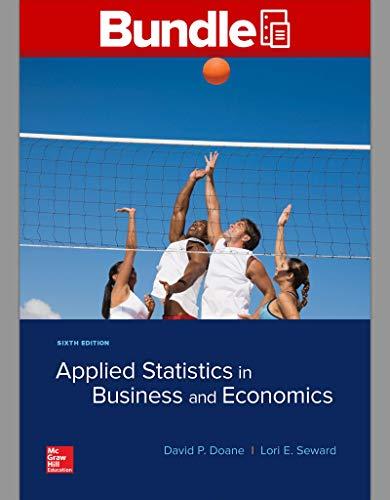
Concept explainers
A multiple-choice exam has 100 questions. Each question has four choices, (a) What minimum score should be required to reduce the chance of passing by random guessing to 5 percent? (b) To 1 percent? (c) Find the
a.
Find the minimum score should be required to reduce the chance of passing by random guessing to 5%.
Answer to Problem 107CE
The minimum score should be required to reduce the chance of passing by random guessing to 5% is 32.12.
Explanation of Solution
Calculation:
It is given that a multiple-choice exam has 100 questions, with 4 options each.
Assume that the random variable X defines the number of correct answers by a student randomly guessing the answers. Consider choosing a correct answer as a success. Then, X has a binomial distribution.
Only 1 out of the 4 options is correct for each question. Thus, the probability of success is
Normal distribution:
A continuous random variable X is said to follow normal distribution if the probability density function of X is,
Binomial distribution:
A discrete random variable X is said to follow binomial distribution if the probability mass function is defined as,
It is known that, when
Here,
Hence,
As the conditions for approximation are satisfied, the normal approximation can be used.
The expected number of the random variable X is,
The standard deviation of the random variable X is,
The approximate normal probability that a student passes by random guessing is 5%.
Denote
Again, the probability
Variable value:
Software procedure:
Step-by-step software procedure to obtain variable value using EXCEL is as follows:
- • Open an EXCEL file.
- • In cell E1, enter the formula “=NORM.INV(0.95,25,4.33)”.
- Output using EXCEL software is given below:
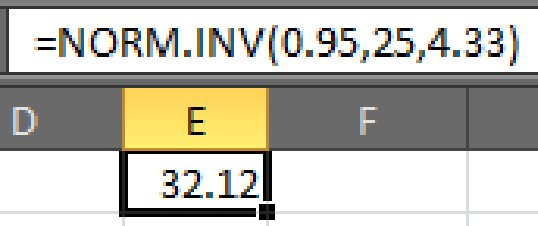
Hence,
Therefore,
Thus, the minimum score should be required to reduce the chance of passing by random guessing to 5% is 32.12.
b.
Find the minimum score should be required to reduce the chance of passing by random guessing to 1%.
Answer to Problem 107CE
The minimum score should be required to reduce the chance of passing by random guessing to 1% is 35.07.
Explanation of Solution
Calculation:
Denote
Again, the probability
Variable value:
Software procedure:
Step-by-step software procedure to obtain variable value using EXCEL is as follows:
- • Open an EXCEL file.
- • In cell E1, enter the formula “=NORM.INV(0.99,25,4.33)”.
- Output using EXCEL software is given below:
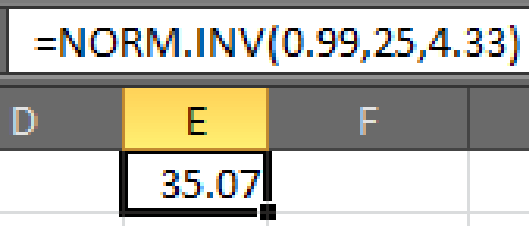
Hence,
Therefore,
Thus, the minimum score should be required to reduce the chance of passing by random guessing to 1% is 35.07.
c.
Find the quartiles for a student who guesses.
Answer to Problem 107CE
The first and third quartiles of scores for a student who guesses are respectively 22.08 and 27.92.
Explanation of Solution
Calculation:
The first quartile of a distribution is the value of the variable, below which, 25% of the observations lie. In other words, the probability that an observation lies below the first quartile is 0.25.
Denote
First quartile:
Software procedure:
Step-by-step software procedure to obtain the first quartile using EXCEL is as follows:
- • Open an EXCEL file.
- • In cell E1, enter the formula “=NORM.INV(0.25,25,4.33)”.
- Output using EXCEL software is given below:
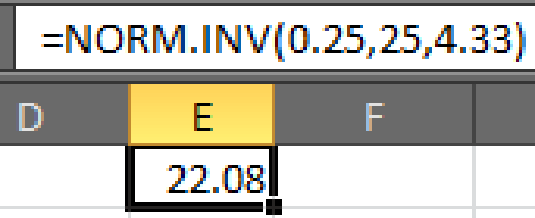
Here,
Hence,
The third quartile of a distribution is the value of the variable, below which, 75% of the observations lie. In other words, the probability that an observation lies below the third quartile is 0.75.
Denote
Third quartile:
Software procedure:
Step-by-step software procedure to obtain the third quartile using EXCEL is as follows:
- • Open an EXCEL file.
- • In cell E1, enter the formula “=NORM.INV(0.75,25,4.33)”.
- Output using EXCEL software is given below:
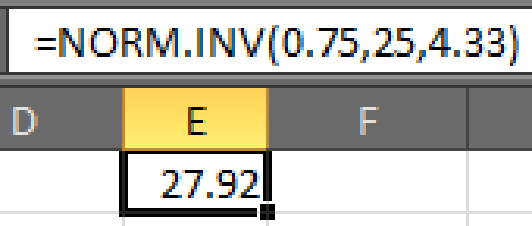
Here,
Hence,
Thus, the first and third quartiles of scores for a student who guesses are respectively 22.08 and 27.92.
Want to see more full solutions like this?
Chapter 7 Solutions
Gen Combo Ll Applied Statistics In Business & Economics; Connect Access Card
- A retail store manager claims that the average daily sales of the store are $1,500. You aim to test whether the actual average daily sales differ significantly from this claimed value. You can provide your answer by inserting a text box and the answer must include: Null hypothesis, Alternative hypothesis, Show answer (output table/summary table), and Conclusion based on the P value. Showing the calculation is a must. If calculation is missing,so please provide a step by step on the answers Numerical answers in the yellow cellsarrow_forwardShow all workarrow_forwardShow all workarrow_forward
- please find the answers for the yellows boxes using the information and the picture belowarrow_forwardA marketing agency wants to determine whether different advertising platforms generate significantly different levels of customer engagement. The agency measures the average number of daily clicks on ads for three platforms: Social Media, Search Engines, and Email Campaigns. The agency collects data on daily clicks for each platform over a 10-day period and wants to test whether there is a statistically significant difference in the mean number of daily clicks among these platforms. Conduct ANOVA test. You can provide your answer by inserting a text box and the answer must include: also please provide a step by on getting the answers in excel Null hypothesis, Alternative hypothesis, Show answer (output table/summary table), and Conclusion based on the P value.arrow_forwardA company found that the daily sales revenue of its flagship product follows a normal distribution with a mean of $4500 and a standard deviation of $450. The company defines a "high-sales day" that is, any day with sales exceeding $4800. please provide a step by step on how to get the answers Q: What percentage of days can the company expect to have "high-sales days" or sales greater than $4800? Q: What is the sales revenue threshold for the bottom 10% of days? (please note that 10% refers to the probability/area under bell curve towards the lower tail of bell curve) Provide answers in the yellow cellsarrow_forward
 Holt Mcdougal Larson Pre-algebra: Student Edition...AlgebraISBN:9780547587776Author:HOLT MCDOUGALPublisher:HOLT MCDOUGAL
Holt Mcdougal Larson Pre-algebra: Student Edition...AlgebraISBN:9780547587776Author:HOLT MCDOUGALPublisher:HOLT MCDOUGAL Glencoe Algebra 1, Student Edition, 9780079039897...AlgebraISBN:9780079039897Author:CarterPublisher:McGraw Hill
Glencoe Algebra 1, Student Edition, 9780079039897...AlgebraISBN:9780079039897Author:CarterPublisher:McGraw Hill Big Ideas Math A Bridge To Success Algebra 1: Stu...AlgebraISBN:9781680331141Author:HOUGHTON MIFFLIN HARCOURTPublisher:Houghton Mifflin Harcourt
Big Ideas Math A Bridge To Success Algebra 1: Stu...AlgebraISBN:9781680331141Author:HOUGHTON MIFFLIN HARCOURTPublisher:Houghton Mifflin Harcourt College Algebra (MindTap Course List)AlgebraISBN:9781305652231Author:R. David Gustafson, Jeff HughesPublisher:Cengage Learning
College Algebra (MindTap Course List)AlgebraISBN:9781305652231Author:R. David Gustafson, Jeff HughesPublisher:Cengage Learning






